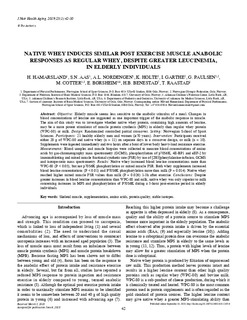| dc.contributor.author | Hamarsland, Håvard | |
| dc.contributor.author | Aas, Sigve Nyvik | |
| dc.contributor.author | Nordengen, Anne Lene | |
| dc.contributor.author | Holte, Kari | |
| dc.contributor.author | Garthe, Ina | |
| dc.contributor.author | Paulsen, Gøran | |
| dc.contributor.author | Cotter, Matthew | |
| dc.contributor.author | Børsheim, Elisabet | |
| dc.contributor.author | Benestad, Haakon Breien | |
| dc.contributor.author | Raastad, Truls | |
| dc.date.accessioned | 2019-04-26T09:32:36Z | |
| dc.date.available | 2019-04-26T09:32:36Z | |
| dc.date.created | 2018-11-06T16:24:01Z | |
| dc.date.issued | 2018 | |
| dc.identifier.citation | The Journal of Nutrition, Health & Aging. 2018, 23, 42–50. | nb_NO |
| dc.identifier.issn | 1279-7707 | |
| dc.identifier.uri | http://hdl.handle.net/11250/2595666 | |
| dc.description | This article is distributed under the terms of the Creative Commons Attribution 4.0 International License (https://doi.org/creativecommons.org/licenses/by/4.0/), which permits use, duplication, adaptation, distribution and reproduction in any medium or format, as long as you give appropriate credit to the original author(s) and the source, provide a link to the Creative Commons license and indicate if changes were made. | nb_NO |
| dc.description.abstract | Objective: Elderly muscle seems less sensitive to the anabolic stimulus of a meal. Changes in blood concentrations of leucine are suggested as one important trigger of the anabolic response in muscle. The aim of this study was to investigate whether native whey protein, containing high amounts of leucine, may be a more potent stimulator of muscle protein synthesis (MPS) in elderly than regular whey protein (WPC-80) or milk. Design: Randomized controlled partial crossover. Setting: Norwegian School of Sport Sciences. Participants: 21 healthy elderly men and women (≥70 years). Intervention: Participants received either 20 g of WPC-80 and native whey (n = 11) on separate days in a crossover design, or milk (n = 10). Supplements were ingested immediately and two hours after a bout of lower body heavy-load resistance exercise. Measurements: Blood samples and muscle biopsies were collected to measure blood concentrations of amino acids by gas-chromatography mass spectrometry (GCMS), phosphorylation of p70S6K, 4E-BP1 and eEF-2 by immunoblotting and mixed muscle fractional synthetic rate (FSR) by use of [2H5]phenylalanine-infusion, GCMS and isotope-ratio mass spectrometry. Results: Native whey increased blood leucine concentrations more than WPC-80 (P < 0.05), but not p70S6K phosphorylation or mixed muscle FSR. Both whey supplements increased blood leucine concentrations (P < 0.01) and P70S6K phosphorylation more than milk (P = 0.014). Native whey reached higher mixed muscle FSR values than milk (P = 0.026) 1-3h after exercise. Conclusions: Despite greater increases in blood leucine concentrations than WPC-80 and milk, native whey was only superior to milk concerning increases in MPS and phosphorylation of P70S6K during a 5-hour post-exercise period in elderly individuals. | nb_NO |
| dc.language.iso | eng | nb_NO |
| dc.subject | skeletal muscle | nb_NO |
| dc.subject | supplementation | nb_NO |
| dc.subject | amino acids | nb_NO |
| dc.subject | protein quality | nb_NO |
| dc.subject | stable isotopes | nb_NO |
| dc.title | Native whey induces similar post exercise muscle anabolic responses as regular whey, despite greater leucinemia, in elderly individuals | nb_NO |
| dc.type | Journal article | nb_NO |
| dc.type | Peer reviewed | nb_NO |
| dc.description.version | publishedVersion | nb_NO |
| dc.rights.holder | © The Author(s) 2018. | nb_NO |
| dc.source.pagenumber | 9 | nb_NO |
| dc.source.journal | The Journal of Nutrition, Health & Aging | nb_NO |
| dc.identifier.doi | 10.1007/s12603-018-1105-6 | |
| dc.identifier.cristin | 1627684 | |
| dc.description.localcode | Seksjon for fysisk prestasjonsevne / Department of Physical Performance | nb_NO |
| cristin.unitcode | 150,31,0,0 | |
| cristin.unitname | Seksjon for fysisk prestasjonsevne | |
| cristin.ispublished | true | |
| cristin.fulltext | original | |
| cristin.qualitycode | 1 | |
